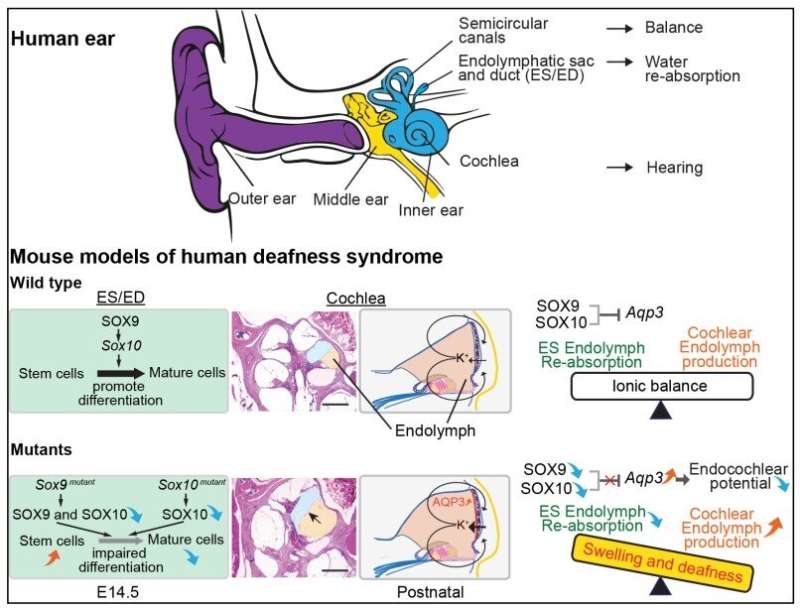Scientists discover two master genes critical for hearing

An international team of scientists led by the LKS Faculty of Medicine, the University of Hong Kong (HKUMed) has uncovered the underlying cause of deafness caused by swelling of the chambers in the inner ear.
Using a mouse model of a human congenital disorder that displays deafness, the researchers identified two master genes controlling hearing function, which opens a new pathway for the diagnosis of deafness and balance problems, and possibly to the effects of stem cells in other tissues and syndromes. This exciting advance is described in their paper published in the journal, Proceedings of the National Academy of Sciences.
Hearing and balance require a functioning inner ear, which houses the sensory organs and a system that mediates the transmission of sound through a fluid filled chamber called the endolymphatic system, comprised of the endolymphatic duct and sac. These tissues help to control the amount of ions within the fluid (called endolymph) in the inner ear and thereby enable sound and balance signals to be transmitted to the nerves and the brain.
Impairment of the endolymphatic system is a common cause of deafness. The endolymph is essential for hearing function. Dysfunction of this fluid results in swelling of the endolymphatic sac (called hydrops) causing hearing loss, vertigo, aural fullness and pain.
HKUMed scientists, leading an international research team, generated and studied mouse models of a human disorder called campomelic dysplasia (CD), a syndrome characterized in part by deafness of unknown etiology.
The team found that the underlying cause of the deafness is deficiency for two master regulatory factors, called SOX9 and SOX10 (collectively called SOXE genes). These factors were found to orchestrate the generation of stem cells in the development of the inner ear.
When these SOXE genes were deficient, the result is an insufficient supply of mature cells that are responsible for ensuring proper ionic composition of the endolymph and a functioning endolymphatic system. As a consequence, the chambers of the inner ear become swollen, causing deafness.
Human hearing loss leads to physical disabilities and generates difficulties in education, employment and social life. One in 10 people are estimated to experience hearing loss by 2050 and one to three newborns per thousand are hearing impaired, of which 50% are due to genetic causes. Malfunction affecting the ionic composition in the endolymph is the most common causes of deafness.
Because SOXE genes are master controllers of many other genes, a further impact of the study is that it provides a rich resource for the discovery of other candidate congenital deafness genes or other disease genes regulated by the SOXE factors. The resource could be a guide for the diagnosis of deafness and balance problems. Since SOXE genes have many roles in development and in stem cells, the principles found could be applicable to effects on stem cells in general in other tissues and syndromes.
Professor Kathryn Cheah Song Eng, Jimmy and Emily Tang Professor of Molecular Genetics and Chair Professor of Biochemistry, School of Biomedical Sciences, HKUMed, who led the study said, "Being deaf can have deep psychological and social impact on the affected individual. Discovering the master controllers of the sound conducting system in the inner ear provides insights into the disease mechanism that will help development of treatment that will have enormous impact on the many people with hearing loss."
Dr. Brian Chung Hon-yin, clinical geneticist/clinical associate professor, Department of Pediatrics and Adolescent Medicine, School of Clinical Medicine, HKUMed, commented, "Congenital deafness is an important indication of referral in clinical genetics. Patients with both syndromic and non-syndromic hearing loss are frequently encountered. Despite recent studies suggesting a genetic diagnosis in up to 50% of patients, the underlying pathophysiology remains complex and poorly understood.
"This exciting work shows convincing evidence of the partnership between SOX9 and SOX10 in controlling the development of the endolymphatic system. It sheds light on the future direction for research of clinical geneticists and scientists in deciphering other conditions of hearing impairment."
More information: Irene Y. Y. Szeto et al, SOX9 and SOX10 control fluid homeostasis in the inner ear for hearing through independent and cooperative mechanisms, Proceedings of the National Academy of Sciences (2022). DOI: 10.1073/pnas.2122121119





















